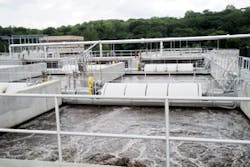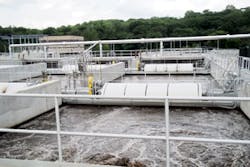Economic development has its price, and sometimes it calls for major upgrades to a community's wastewater treatment facilities.
Such was the case in the city of Fort Dodge, Iowa. Expansion of new Cargill and CJ Bio America plants in the nearby Iowa Crossroads of Global Innovation industrial park required additional capacity as well as biological oxygen demand (BOD) and total kjeldahl nitrogen (TKN) removal capabilities at the Fort Dodge Water Pollution Control Facility (FDWPCF).
The two agricultural production plants added about 5 million gallons per day (MGD) of flow to the FDWPCF and increased BOD and TKN loadings by 100 and 300 percent, respectively. To meet the new treatment requirements, Fort Dodge chose to expand the biological treatment technology it had been using for several years -- the Vertical Loop Reactor (VLR) process from the Envirex® product group of Evoqua Water Technologies.
Essentially an oxidation ditch tipped on its side, the VLR not only saved on construction costs and footprint requirements when compared to conventional treatment, it gave the Fort Dodge plant the ability to simultaneously nitrify and denitrify.
"We selected VLRs back in 1998 when we faced new ammonia limits," said Mike Trotter of McClure Engineering Company, Fort Dodge, the design firm on the project. "We decided to install suspended growth biological technology to replace our old two-stage trickling filters."
"We looked at several biological processes, and the VLR offered more flexibility," he said, noting that the design team and the city were looking ahead to anticipated nutrient removal requirements for the future.
Two VLRs were installed then, and a third has been added in the new project, which also includes a new final clarifier, pumping stations, an aerobic digester, and a blower and chemical building, in addition to rehabilitation of the existing ultraviolet (UV) disinfection system.
The total project cost was $23 million to increase primary treatment capacity to 12.0 MGD and secondary treatment to 18.6 MGD. The schedule for the project was very tight. McClure Engineering completed the plant design at the end of 2011, bidding was completed in late 2012 and plant startup was mid-2014. The contractor was Gridor Construction of Buffalo, Minn., and the plant is operated for the city by US Water.
VLR Technology
Each VLR train includes four tanks. In the first two tanks, Envirex disc aerators provide mechanical aeration, which is closely controlled to create anoxic conditions (zero dissolved oxygen, or DO) and maintain the desired oxidation reduction potential (ORP). These aerated anoxic conditions facilitate true simultaneous nitrification-denitrification in the same tank. In the third and fourth tanks, aerobic conditions are maintained by disc speed, which is typically constant, and by the addition of oxygen through course bubble diffusers.
Contents from the fourth tank in each VLR are recycled to the first and second tanks to supplement total nitrogen removal. Overall, up to 90 to 95 percent removal is achieved. A new "smart" biological nutrient removal (BNR) control system, supplied by Evoqua, uses DO and ORP monitors in each tank to control the operation of the discs, blowers and internal recycle pumps.
Trotter pointed to the flexibility of the process, noting that the plant can control power usage on each of the three VLRs and can split, block or proportionately distribute return activated sludge (RAS) according to wastewater characteristics and treatment objectives. He said that normally, the plant operates at 2 mg/L DO out of the final tank, with additional DO added as the water passes over the finger weirs in the UV system.
Ready for the Future
Trotter also noted that the VLR installation will enable the plant to remove phosphorus biologically (if required in the future) without having to add any more tanks.
At the moment, it is not clear whether more production facilities will be added to the industrial park, but if they are, the FDWPCF will be prepared. "The VLR is the best application for dealing with total nitrogen and phosphorus limits in the future," Trotter said.
Evoqua Water Technologies is an exhibitor at WEFTEC.14 and can be found at Booth 5129. For more information, visit www.evoqua.com.




